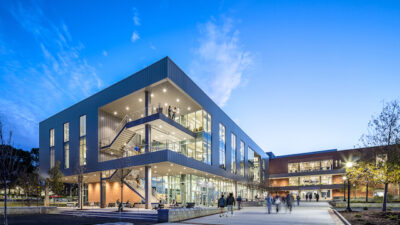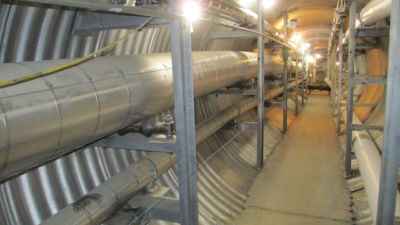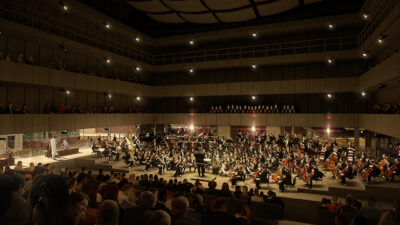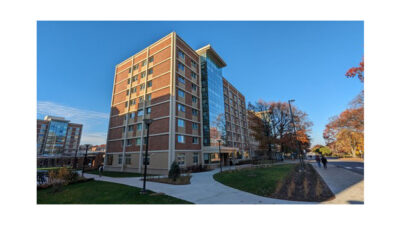K-12 schools are adopting net zero energy goals and implementing innovative sustainability measures, such as photovoltaic arrays, HVAC condensation recovery systems and advancements in energy recovery products.

K-12 insights
- Increasingly, HVAC condensation recovery systems are being integrated into building designs to redirect waste water for cooling tower makeup and irrigation.
- The evolution of energy recovery products, from aluminum plate heat exchangers to energy wheels and cores, offers K-12 projects a range of options for efficient heat recovery.

Respondents:
- Keith Hammelman, PE, Principal, CannonDesign, Chicago
- Sean Holder, P.E., Principal, Salas O’Brien, Houston
- Steven Mrak, PE, Vice President, Peter Basso Associates, Inc., Troy, MI
- Johnny P. Wood, PE, LEED AP BD+C, CxA, CPD, Associate Vice President, Regional Market Segement Leader, Dewberry, Raleigh, NC
What level of performance are you being asked to achieve, such as WELL Building Standards, U.S. Green Building Council LEED certification, net zero energy, RESET or other guidelines? Describe a project and its goals, identifying the geographic location of the building.
Keith Hammelman: In California we are seeing the drive toward net zero energy on all new K-12 schools and certification with the CHPS program. The current version of the California Energy Code is also requiring that a minimum level of Photovoltaic (PV) and battery storage is prescriptively provided for all new construction projects. We are presently working on a series of projects with Los Angeles Unified School District with the goal of designing a facility for 100% offset of the annual energy use for the new construction to be incorporated into campus design. We are often seeing the use of roof mounted PV arrays meeting minimum code requirements for clearances at the edge of the building and around equipment. In these cases, we are also seeing the introduction of canopies installed on over the parking areas to meet net zero energy requirements.
What unusual systems or features are being requested to make such projects more energy efficient?
Sean Holder: There have been several recent requests to implement HVAC condensation recovery and treatment systems to redirect waste water from the sewage systems into other building systems such as cooling tower makeup and irrigation.
Johnny P. Wood: We have several K-12 clients who request polypropylene random piping for underground applications. This piping has a long life and very reasonable friction loss.
What types of sustainable features or concerns might you encounter for these buildings that you wouldn’t on other projects?
Johnny P. Wood: We often see cases where more energy-efficient systems are more complex and require additional maintenance. A very important aspect of the design and operation of the systems is to verify the owner has the personnel and capability to maintain these types of systems.
What types of renewable or alternative energy systems have you recently specified to provide power? This may include photovoltaics, wind turbines, etc. Describe the challenges and solutions.
Keith Hammelman: We are predominantly seeing the use of PV arrays being provided at campuses to provide on-site renewable energy for our projects. We are also starting to see a push toward the use of battery storage systems to capture this energy for future use. One challenge is figuring out how to ensure that we are meeting local requirements for the installation of the PV arrays on roofs while also maintaining the required code clearances from parapets and other equipment on the roof to make this a cost-effective solution. To ensure the maximum benefit is provided, we are working early in the design process to identify the locations for PVs on roofs. We are also working with the design team to ensure that all the energy consuming systems are optimized to reduce the needs of the renewable energy system.
Johnny P. Wood: We have been including PVs on many of our K-12 projects. Some challenges with these systems are building orientation that achieves maximum performance, size of the system to match the energy use and whether to include batteries for storage of energy during low use periods.
How have energy recovery products evolved to better assist in designing these projects?
Steven Mrak: Airside aluminum plate heat exchangers are a nice balance of simplicity and performance, especially for districts that don’t have extensive maintenance staffs. However, with these devices limited to sensible heat recovery only, energy wheels and energy cores provide total energy (sensible and latent) recovery. Energy recovery wheels introduce moving parts (wheel motor and/or belts) that come with some inherent maintenance, while energy recovery cores offer a nice combination of total energy recovery with little to no moving parts.
Johnny P. Wood: Energy recovery product performance has increased from the previous generation of products: from flat plate heat exchangers to heat pipe type to the current energy wheels, which transfer sensible and latent energy. Each of these heat recovery devices has different maintenance requirements and should be discussed with the owner before specifying.



